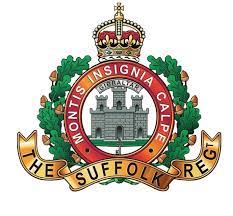In June 1944, the first battalion of the Suffolk Regiment received the role of reinforcement company of the 8th Infantry Brigade tasked within the Third British Division with storming the beach coded “SWORD” located between Ouistreham to the East and Lion sur Mer to the West. The regiment underwent specific and intense training including several landing exercises on the coasts of Scotland and the Isle of Wight.
The mission of the 1st Battalion of the Suffolk Regiment was to disembark an hour after the two assault battalions (2nd Battalion East Yorkshire Regiment and 1st Battalion South Lancashire Regiment), to cross the coastal defenses, to clear the village of Colleville sur Orne at 2 .5 km inland, to seize a battery of cannons under armored casemates (code name: Morris) and finally to storm the German headquarters of the sheltered sector in a fortified position (code name: Hillman) located south of the village.
The First Battalion of the Suffolk Regiment was supported by a squadron of tanks from the 13/18th Royal Hussars, two batteries from the 76th and 33rd Regiment Royal Artillery, a detachment from the 246th company of the Royal Engineers (engineering), a machine gun platoon from the 2nd Battalion, Middlesex Regiment and a detachment from the 8th Ambulance Corps. Finally, the fortified positions must undergo aerial and naval bombardment before the assault.
The landing
As soon as it arrived on land around 8:30 a.m., the Battalion was subjected to enemy fire still directed at the beaches and suffered its first losses. After regrouping with armored support in the planned area, the unit begins the progression towards Colleville. Around 10:30 a.m. it then joined the 1st Special Service Brigade of commandos commanded by Lord Lovat which turned south-east towards Bénouville and the “Pegasus Bridge”.
Company C, supported by a few armored vehicles, begins the liberation of Colleville, poorly defended by a few snipers.
Company B prepared a full-scale attack on the Morris position west of the village, intact despite air and naval bombardment. The 67 defenders were, however, greatly shocked and surrendered before the infantry launched the attack. The position is definitely cleared by noon.
Company A suffered casualties after passing through the village while preparing to attack Hillman. This preparation was seriously hampered by the death of the officers responsible for liaising with the bombing ships. In addition, the radio devices work very poorly: as a result, the site will not be subject to naval bombardment. Finally, the first reconnaissance carried out by the regiment led to the discovery of the existence of armored domes on the site. This defense element had escaped Allied aerial reconnaissance.
Hillman’s Take
At 1:10 p.m., an artillery preparation was directed at Hillman. Five minutes later, companies A (reinforced with a platoon from D), B and C launched the attack. Hindered by barbed wire and minefields, the men were mowed down by German machine guns. The domes are intact despite the preliminary bombardment. The attackers return to their starting position with several losses.
A second attack is then launched. Sappers are sent to clear corridors in barbed wire networks and minefields.
The attack resumed around 4:30 p.m. after further artillery preparation. Tanks use the cleared corridors and thus allow the infantrymen of the Suffolk Regiment to approach the machine gun nests and especially the domes which are still firing continuously. One of them, however, is neutralized by soldier Hunter who exposed himself very dangerously to approach it. Little by little the British managed to neutralize all the firing sites. At 8 p.m., the Suffolk Regiment took 50 prisoners on the site and cleared the Beauvais farm to the south, also fortified by the Germans. He then put himself in a defensive position in fear of a counterattack from German armor reported north of Caen.
However, the site still has a surprise in store for the soldiers of Suffolk: Colonel Krug, commanding the 736th German Grenadier Regiment, remained locked in a blockhouse with 70 men. He managed to reach his superior General Richter of the 716th Division by telephone at his command post established in an underground tunnel near Caen (the underground tunnel still exists and is part of the Peace Memorial). The Colonel explains his situation: “The enemy is on my blockhouse, I have no means of resisting him and I have no communication with my men. What should I do?” The General, after consultation with other officers who witnessed the scene (General Feuchtinger commanding the 21st panzer division and Colonel Meyer commanding a regiment of the 12th SS panzer division) replied to the besieged that he could no longer give him any order and leaves him master of his decision.
On June 7, 6:45 a.m., Colonel Krug and his men surrendered to the British.
Balance sheet
The First Battalion of the Suffolk Regiment achieved its D-Day objectives and took around 200 prisoners.
His losses were 7 killed and 25 wounded.
The supporting troops also suffered: 1 dead and 7 wounded for the armor of the 13/18 Hussars, 1 wounded for the Royal Engineers, 1 dead and 6 wounded for the 2nd Middlesex Regiment and finally several artillery liaison officers.

